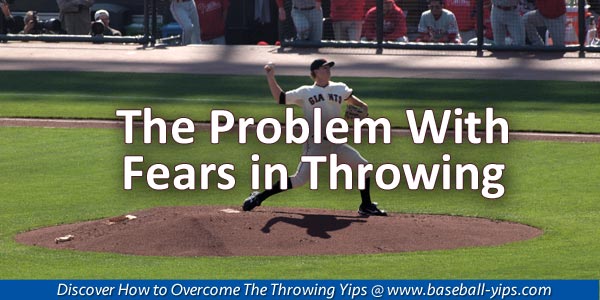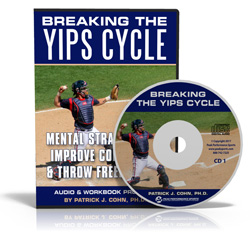How The Full Blown Throwing Yips Start
Rick wrote to me about his 15-year-old son saying he’s always been a good multi-position player since he was very young, but now has problems with his throwing.
During a tournament, for some reason out of the blue, he suddenly could not throw the ball back to the pitcher or 3rd base.
“He would flick the ball and it would land at the feet of the pitcher. After a couple of batters, the coach pulled him from the game,” Rick said.
Rick’s son reported that the ball just “felt weird, too heavy, or too light at times.” And all of a sudden, he became mechanical with his throwing.
This spring, things got even worse… His son would literally stop in the middle of throwing motion when throwing back to the pitcher—he couldn’t release the ball.
He would pump 3 or 4 times, before lobbing the ball back to the pitcher’s feet. This player has gone from a very valuable player on the team to someone that may get cut after fall ball tryouts.
This is the start of the full blown throwing yips.
Often it starts with a bad outing of throwing or making throwing errors…
The fear of making more bad throws can paralyze players because they become hyper focused on mechanics and what their arm feels like. Call it over analysis, over thinking, or trying too hard to make a good throw.
Players in this situation think that’s what is needed to get back on track. “I have to think about making a good throw if I don’t want to make a bad throw.” Sounds like the correct thing to do, right?
However, this leads to over thinking mechanics of the throw (something that was natural to do) and thus the freezing. Stopping in the middle of the throw or pumping is at the height of this process. It’s too scary to release the ball.
Catchers I work with will often just use a lob or safe throw back to the pitcher so they don’t make a bad throw that can lead to giving up bases for runners.
What I do know about the throwing yips is that it’s not a mechanical problem, but that’s how most players try to fix it.
The problem is all about fear: fear of embarrassment and not wanting to let down teammates or coaches. The fear is what binds up players and causes them to go to the safe throw.
What is the solution?
The solution is not easy because you have to attack the yips cycle at every stage. For example, ball players have to:
- Let go of what they think coaches, teammates, and parents expect of them.
- Focus on the process instead of worrying about the bad throw.
- Regain their intuitive or natural throwing action, what I call free up their arm.
- Overcome the fear of embarrassment of letting down others.
- Regain confidence in their throw to help trust their natural throwing motion again.
The yips are not a disease. Players don’t catch a cold and get the yips. The yips are not due to faulty mechanics.
I don’t have any quick tips to help players overcome their throwing issues. Instead, ball players have to work to overcome the fear and learn to throw naturally or freely again.
My two best options to help ball players with throwing problems include:
- One on one personal mental game coaching (weekly).
- “Breaking the Yips Cycle” audio and workbook program (included with person coaching).
Everyone asks me: “What’s your success rate with curing the yips?”
My answer: It’s not about “success rates” or “a cure.” Instead, the solution is education about the problem and developing strategies to learn how to cope with the fear and learning to throw freely.
It’s not an all or none challenge. I teach players to be able to throw freely 50% of the time and then 75% with the goal of 95% eventually.
If you or your ball players know it’s a mental issue, and not physical, you’re now receptive and open to working on the mental game.
Related Baseball Articles:
- How to Have More Good Throwing Days
- Baseball Players’ Fears And Throwing Problems
- Catchers Who Alter Throwing Mechanics
 Breaking The Yips Cycle Audio
Breaking The Yips Cycle Audio
If you can throw well when alone, but can’t take it to games, this is a mental game issue and not a physical challenge!
The Yips Cycle is a vicious cycle that causes ball players to stay trapped in overthinking and over control…
Learn to throw or pitch freely again with my proven audio and workbook program!


 Breaking The Yips Cycle Audio
Breaking The Yips Cycle Audio